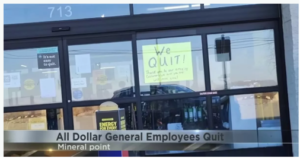There is an incredible amount of data corroborating the deep relatedness between customer satisfaction and employee satisfaction. Some of this work focuses specifically on customer-facing employees proving, as reported in Journal of Applied Psychology, that this relationship is indeed reciprocal. Increasing employee satisfaction leads to happier customers, and creating happier customers increases job satisfaction in customer-facing employees (Zablah, Carlson, Donavan, Maxham, and Brown, 2016).
This data makes sense, but it misconstrues the point by focusing on one layer of the organization. We would think, naturally, that employees are happier when they interact with happy customers, and customers are happier when they interact with happy employees. This is true, but it is a superficial truth if you want to understand why and how customer and employee satisfaction is correlated. From the customer’s perspective, hearing that “smile” in the employee’s voice can help, but being sent to five different agents in order to solve a simple problem will still breed rampant dissatisfaction. There is a much deeper principle at work in satisfying customers and employees.
The entire organization, on micro and macro scales needs to be able to collaborate and improve, so that today’s annoyances are solved before they become real problems. The key to satisfaction, in both workers and customers, resides in the same fundamental capability: organizations must be able to listen, and employees must be able to enact real change.
Quicken Loans has innovated a process for delivering continual change while providing a stable cultural structure. It is elegantly simple, and it works splendidly. Here are some of their accolades. The trickle started thirteen years ago, but they have really caught fire in the previous seven years.
- Computerworld’s 100 Best Places to Work in IT list for the last 13 years
- Eight of those years they have ranked #1
- Five of those eight have come in the most recent, consecutive 5 years
- JD Power award for customer satisfaction for primary mortgage origination for the last seven consecutive years
- In 2016, closed $96 billion in mortgages (DNA of Engagement, 2018)
- #14 on Fortune Best Places to Work (Fortune, 2018)
- Quicken Loans becomes the nation’s largest mortgage lender in January 2018
These bullets tell the full story of how Quicken Loans transforms from the inside out, beginning with its culture and employees, thus impacting customer satisfaction, satisfied customers leading to rampant growth and interstellar rise in industry. This pattern is not unique, but it is always an inspiration to watch.
How they have satisfied employees and customers consistently over the last 13 years shows quite plainly why and how these very different corporate vital stats, customer and employee satisfaction, and corporate profits, are intrinsically tied. But their process is also remarkably easy to understand, which makes them a fascinating case study.
Employee Engagement Case Study of Quicken Loans
Where most Fortune 100 companies, especially financial companies, contend with bureaucratic red tape, even in employee engagement processes, Quicken Loans has created an elegant infrastructure that focuses on just two things: cultural traditionalism on the one hand and organizational change on the other.
Cultural Stability
Human Resources has attempted to quantify culture for decades, and psychologists have dealt with (and been flummoxed by) similar questions since Freud. When a business wants to create a workplace where people just get along, tons of professionals will provide extremely detailed and complex answers, none of which in my knowledge work extremely well, and certainly not elegantly.
Quicken Loans solves this problem with a simple solution. The way they see it, like attracts like, so why try to quantify something qualitative, like culture, when quality attracts quality?
In other words, they focus on a strong referral program. Quicken Loans performs community outreach and partners with universities, but the referral program, which encourages employees to recruit family, friends, and acquaintances who they think would be a good fit for the culture. This might be a simple way to create an environment where everyone enjoys working together, but it clearly works to create a solid, dependable cultural environment where collaboration is natural. This characteristic becomes important whenever a group wants to change.
Create a Strong Employee Feedback Loop
*ISMs are the ideals Quicken Loans employees live by
The other differentiating capability of Quicken Loans is its employee feedback loop. The company makes absolutely certain that it can listen to employees and execute real change, slashing antiquated policies, (what I like to call moose), and improving the business. This capability is the crux of their competitive advantage, and it is worth copying.
How to ensure employees have a meaningful outlet
Quicken Loans deploys multiple channels to promote feedback from employees. They also take pains to ensure that the feedback received is distributed to the most appropriate personnel to fix the problem. And they train those personnel to identify top opportunities from that data, and to enact real change. Further safeguards are put into place so that persistent problems that fail to correct are given extra attention until they are solved.
This closed-loop system validates employee feedback and builds trust, improves morale, and at the same time helps the organization change very quickly.
The crux of the employee engagement mechanism is the Outlet Survey. Quicken Loans is not the first company to disseminate Outlet Surveys twice per year; however, employees understand and trust that this survey is important, not only to them but to the company as a whole. Participation in these surveys is off-the-charts (94%, according to The Conference Board) because:
- Feedback is encouraged
- Feedback is valued at the corporate level and posted as an ideal to live by (ISM)
- Feedback results in definitive change
This last bullet is the most difficult to achieve, and Quicken Loans takes exhaustive steps to ensure this last bullet will be sustained indefinitely. My team splits execution into two steps, one is thorough identification, the next is follow-through.
On the team level, Quicken Loans requires that issues are identified, prioritized, and understood by all relevant personnel, ensuring that everyone is primed for change where change is needed.
- Survey results are shared with all leaders
- Team leaders are encouraged to ask for help and additional resources from senior leaders
- Team leaders are tasked with identifying at least one goal for improvement from survey results
- This one goal is input into a performance management system, where it cannot be erased without being solved
- Team results are shared at the team level, when the unit discusses the good, and the challenges they need to work on
- The Outlet Surveys include the question: “Do you feel that any action has been taken based on results from the last survey?” This helps to identify persistent, unresolved problems
After problems are thoroughly understood, they are shared with a talent development team, which provides support, coaching, guidance, and training to team members and leaders.
In addition to team-level challenges, employees are also encouraged to use two other channels:
- A business unit called the “Cheese Factory,” which executes changes on a larger scale
- Speak directly with team leaders to understand specific processes, or to initiate the change process at the team level
Quicken Loans’ strategy is like a great coffee: simple to understand but with execution that is thorough and robust. With three different channels in place to send feedback, with feedback promoted through culture, values, and business process, with discrete tracking to ensure accountability and follow through, with resources provided where and when necessary, the company has created an air-tight system to propel change to completion.
Employee Engagement Becomes Customer Satisfaction and Wild Success
Of all the companies we have analyzed, Quicken Loans is our favorite because they have the simplest recipe for stellar employee engagement and the clearest success story to show how employee engagement drives customer satisfaction and ultimately success.
By analyzing the wazoo out of a standout corporate entity, I hope to leave you with a few overarching takeaways. First, kill the moose. Let employees remove the antiquated processes and red tape that they and customers hate. For further study of these buffoonish creatures, where to find them, and how to kill them, please read A Prerequisite for Customer Centricity and Transformative Growth.
Secondly, the most important and difficult element of engagement is the trust that feedback is heard. Quicken Loans, and any company, can only establish trust by creating a system that executes the changes employees and customers have asked for. Building a system like Quicken Loans’ is not impossible; sustainable feedback requires dedication, or if you prefer, brute stubbornness. But it is well worth the effort.
Sources
Corporate Executive Board, The. “Preparing Your Employment Value Proposition for 2016.” Gartner: Stamford, CT. Accessed on July 9, 2018.
Fortune. “The 100 Best Places to Work for 2018.” Time, Inc.: New York, NY, 2018. Accessed on July 10, 2018.
Zablah, A. R., Carlson, B. D., Donavan, D. T., Maxham, J. G. III, and Brown, T. J. “A cross-lagged test of the association between customer satisfaction and employee job satisfaction in a relational context.” Journal of Applied Psychology, 101(5), 743-755.






